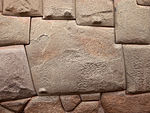

A chultún (or chultun, plural: chultunob' or chultúns) is a bottle-shaped underground storage chamber built by the pre-Columbian Maya in southern Mesoamerica. Their entrances were surrounded by plastered aprons which guided rainwater into them during the rainy seasons. Most of these archaeological features likely functioned as cisterns for potable water.
Chultunob' were typically constructed in locations where naturally occurring cenotes were absent (such as the Puuc hills, which sit hundreds of feet above the Yucatán Peninsula aquifer). While many were constructed to collect water, not all may have served that purpose. Some chultúns may have been used for storage of perishable comestibles or for the fermentation of alcoholic beverages. Experimental research conducted in the 1960s by Mayanist Dennis E. Puleston demonstrated that chultúns around Tikal were particularly effective for long-term storage of ramon nuts (Brosimum alicastrum).
Associated with water, rain, and child sacrifice, chultunob' are widely viewed as points of access to the Maya underworld. This makes chultunob' an excellent source of information on both the life and death of ancient settlements of the Prehispanic Maya.
See also
- Americas (terminology)
- Indigenous peoples of Mexico
- Indigenous peoples of the Americas
- Mesoamerican region
Notes
- Sinkholes formed in limestone karst.
- Stavrakis-Puleston, Olga (2015). Settlement and Subsistence in Tikal, The assembled work of Dennis E. Puleston (Field research 1961-1972). Oxford: British Archaeological Reports. ISBN 9781407314198.
- Barquera, Rodrigo; Del Castillo-Chávez, Oana; Nägele, Kathrin (June 12, 2024). "Ancient genomes reveal insights into ritual life at Chichén Itzá". Nature. 2024 (8018): 912–919. Bibcode:2024Natur.630..912B. doi:10.1038/s41586-024-07509-7. PMC 11208145. PMID 38867041.
External links
 Media related to chultunob at Wikimedia Commons
Media related to chultunob at Wikimedia Commons- Mesoamerican Photo Archives
| Native American architecture | ||
|---|---|---|
| Styles |  | |
| Building types | ||
| Structures | ||
| Elements | ||
This article related to indigenous Mesoamerican culture is a stub. You can help Misplaced Pages by expanding it. |